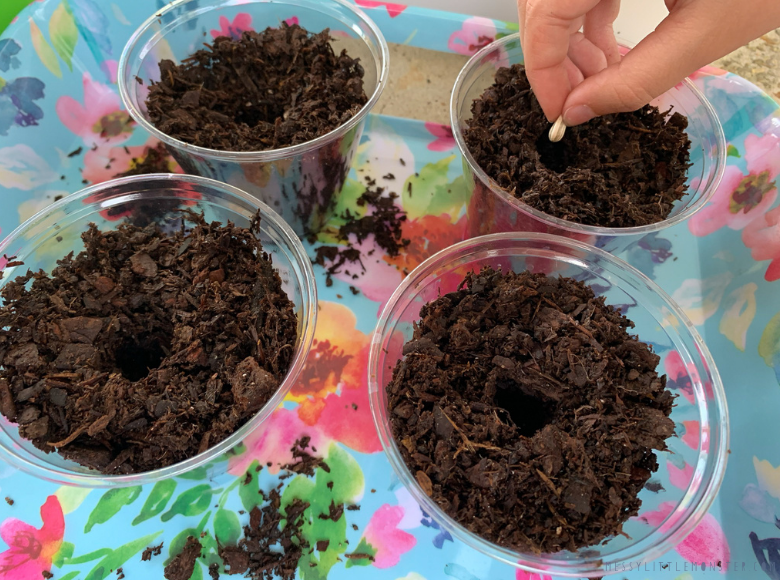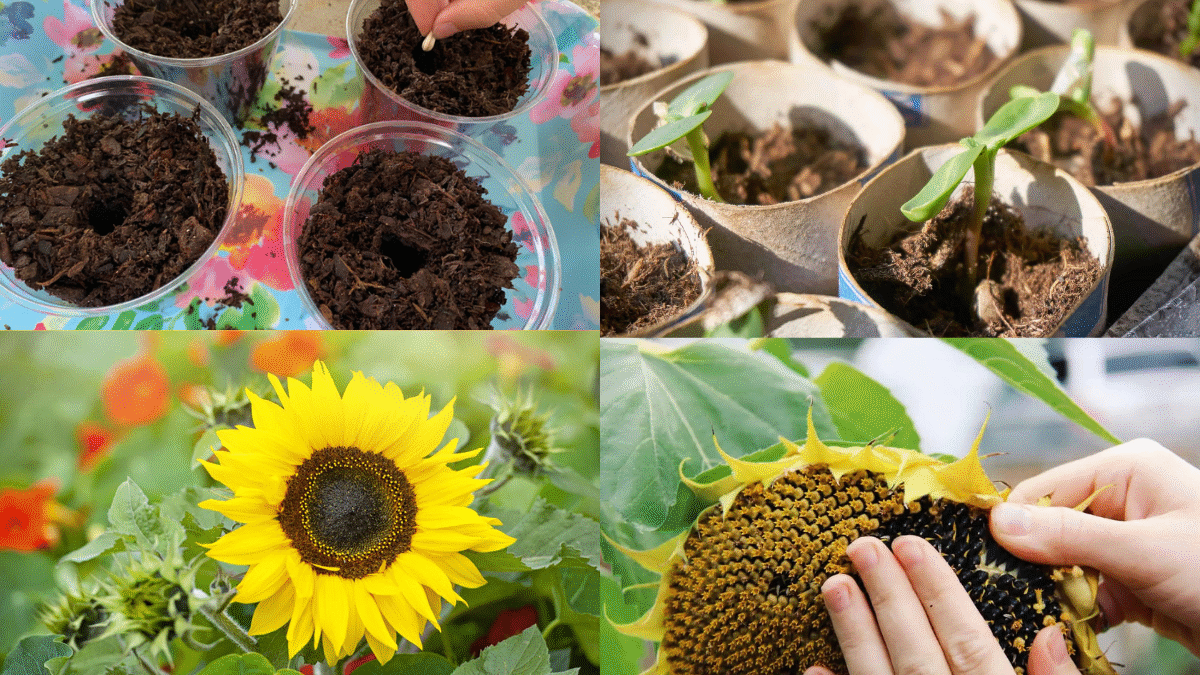Few flowers capture the spirit of summer quite like sunflowers. With their cheerful yellow petals and towering stems, sunflowers are a favorite in both gardens and landscapes. Not only do they add bright, bold color, but they also attract pollinators like bees and butterflies, and can provide nutritious seeds for people, birds, and other wildlife.
If you’ve ever dreamed of having a backyard filled with these golden blooms, you’re in luck — sunflowers are surprisingly easy to grow. In this detailed guide, we’ll cover how to plant sunflower seeds for beautiful blooms, from choosing the right variety to harvesting seeds at the end of the season.

Why Grow Sunflowers?
Sunflowers are a gardener’s favorite for many reasons:
- Easy to grow: Perfect for beginners and kids.
- Beautiful and bold: Instantly brightens any outdoor space.
- Attract pollinators: Supports bees, butterflies, and birds.
- Versatile varieties: From towering giants to compact potted types.
- Edible seeds: Enjoy roasted, or leave for the birds.
Whether you’re growing them for beauty, bees, or snacks, sunflowers are a garden staple you’ll want to plant every season.
Types of Sunflowers to Plant
Before you start planting, it’s helpful to know that sunflowers come in a range of sizes, colors, and bloom shapes. Here are the most popular types:
Giant Sunflowers
- Grow up to 12-16 feet tall
- Large flower heads up to 18 inches wide
- Great for garden backdrops or competition growing
- Example: ‘Mammoth’
Dwarf Sunflowers
- Stay compact at 1-3 feet tall
- Ideal for small gardens, containers, and borders
- Example: ‘Teddy Bear’, ‘Little Becka’
Multi-branching Sunflowers
- Produce multiple blooms per plant
- Extended blooming period
- Example: ‘Autumn Beauty’, ‘Velvet Queen’
Ornamental Varieties
- Unique colors like red, burgundy, orange, and lemon yellow
- Perfect for cut flower arrangements
- Example: ‘Cherry Rose’, ‘Lemon Queen’
When to Plant Sunflower Seeds
Sunflowers are warm-season annuals that thrive in full sun and warm soil. The ideal time to plant is:
- After the last frost date in your region
- When soil temperatures reach at least 55°F (13°C) — ideally 60-70°F (15-21°C)
In most areas, this means planting sunflower seeds in late spring, typically between April and June.

Where to Plant Sunflowers
Sunflowers need full sun, so choose a spot that receives at least 6-8 hours of direct sunlight per day. Good drainage is also important, though sunflowers can tolerate a variety of soil types.
Site requirements:
- Open, sunny location
- Well-drained soil
- Protection from strong winds (especially for tall varieties)
- Avoid planting near potatoes or pole beans, which can compete for nutrients
Pro Tip: Plant taller varieties at the north or back side of your garden to prevent shading smaller plants.
How to Prepare the Soil
Sunflowers aren’t too fussy about soil, but you’ll get the best blooms in nutrient-rich, loose soil.
Steps for soil preparation:
- Remove any weeds, rocks, and debris.
- Loosen the soil to a depth of 12-18 inches.
- Mix in 2-3 inches of compost or aged manure to improve fertility and drainage.
- Test your soil’s pH; sunflowers prefer slightly acidic to neutral soil (6.0 to 7.5).
How to Plant Sunflower Seeds
Sunflowers grow best when direct-seeded into the ground, as they don’t like being transplanted.
Spacing and Planting Depth
- Plant seeds 1 inch deep.
- Space seeds 6 inches apart for smaller varieties, 12-24 inches apart for larger types.
- Rows should be 24-36 inches apart for easy access.
Planting steps:
- Dig small holes to the recommended depth.
- Drop a seed into each hole, pointed end down.
- Cover lightly with soil and press gently.
- Water the area thoroughly.
Pro Tip: For a continuous display of blooms, plant new seeds every 7-10 days for several weeks.

Watering Sunflowers
Sunflowers need consistent moisture, especially during germination and early growth.
Watering tips:
- Keep the soil evenly moist until seeds sprout (usually 7-10 days).
- Once established, sunflowers are drought-tolerant but still appreciate 1 inch of water per week.
- Water deeply at the base of the plant to encourage deep roots.
- Avoid overhead watering to prevent fungal diseases.
Fertilizing Sunflowers
Sunflowers can thrive in average garden soil, but they’ll benefit from occasional feeding, especially in poor soil.
Fertilizing tips:
- Mix a balanced, slow-release fertilizer into the soil before planting.
- Apply a diluted liquid fertilizer (such as 10-10-10) once a month during the growing season.
- Avoid over-fertilizing, which can lead to excessive foliage at the expense of flowers.
Caring for Growing Sunflowers
As sunflowers grow, a little maintenance will keep them healthy and strong:
- Thin seedlings: When plants reach 4-6 inches tall, thin them to their final spacing to reduce competition.
- Support tall varieties: Use stakes or garden twine to support sunflowers over 6 feet tall, especially in windy areas.
- Mulch around plants: Apply 2 inches of mulch to conserve moisture and control weeds.
Common Pests and Problems
While generally low-maintenance, sunflowers can occasionally face challenges:
Pests:
- Aphids: Spray with insecticidal soap.
- Cutworms: Protect young seedlings with collars or sprinkle diatomaceous earth around stems.
- Birds and squirrels: Use netting or reflective objects to deter seed thieves.
Diseases:
- Powdery mildew: Improve air circulation and avoid overhead watering.
- Rust: Remove affected leaves and water early in the day.

Harvesting Sunflowers
Sunflowers are ready for harvest in 70-100 days, depending on the variety.
For Flower Bouquets:
- Cut blooms when the petals start to unfurl.
- Harvest early in the morning for freshest flowers.
- Remove lower leaves and place stems in water immediately.
For Seeds:
- Wait until the flower heads droop and the back turns brown.
- Seeds should be plump and the outer shell should be hard.
- Cut the head with 12-18 inches of stem and hang upside down in a dry, well-ventilated area.
Once dry, rub the seeds from the head by hand or with a stiff brush.
Pro Tip: Roasting your own sunflower seeds is simple — soak in salted water overnight, drain, and bake at 300°F (150°C) for 30-40 minutes.
Final Thoughts
Sunflowers are a joy to grow and can transform your garden into a vibrant, pollinator-friendly paradise. Whether you opt for towering giants or charming dwarf varieties, following this guide on how to plant sunflower seeds for beautiful blooms will help you cultivate a spectacular, sunny display all season long.
So grab a packet of seeds, pick a sunny spot, and get ready to watch those golden faces turn toward the sky — there’s no better way to celebrate summer than with a patch of blooming sunflowers.





Leave A Comment